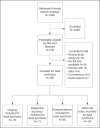'No cyst, no echinococcosis': a scoping review update on the diagnosis of cystic echinococcosis after the issue of the WHO-IWGE Expert Consensus and current perspectives
- PMID: 37466103
- PMCID: PMC10487401
- DOI: 10.1097/QCO.0000000000000941
'No cyst, no echinococcosis': a scoping review update on the diagnosis of cystic echinococcosis after the issue of the WHO-IWGE Expert Consensus and current perspectives
Abstract
Purpose of review: In 2010, the WHO-Informal Working Group on Echinococcosis (IWGE) published an Expert Consensus on the diagnosis and treatment of echinococcal infections. We provide an update on the diagnosis of cystic echinococcosis through a scoping review of the literature published after the release of the WHO-IWGE document.
Recent findings: Ultrasound accurately and reliably depicts the pathognomonic signs of cystic echinococcosis (CE) stages compared with other imaging techniques. Among these, T2-wighted MRI is to be preferred to computed tomography, which has poor performance for the etiological diagnosis of CE. A negative serology cannot exclude the diagnosis of CE, while a positive serology, applied after the visualization of a CE-compatible lesion, may confirm a CE diagnosis. Serology alone must not be used to define 'CE' nor as 'screening' tool for infection. Other imaging and laboratory techniques did not show clinically applicable performances.
Summary: In the absence of a focal lesion compatible with a CE cyst, no diagnosis of CE should be attempted. There is urgent need to achieve univocal CE case definitions and consensus diagnostic algorithm, as well as standardization of diagnostic methods and issue of a Target Product Profile of CE diagnostics, as advocated by the WHO in the 2021-2030 roadmap for neglected tropical diseases (NTDs).
Copyright © 2023 The Author(s). Published by Wolters Kluwer Health, Inc.
Conflict of interest statement
Figures
Similar articles
-
Watch-and-wait approach for inactive echinococcal cysts: scoping review update since the issue of the WHO-IWGE Expert Consensus and current perspectives.Curr Opin Infect Dis. 2023 Oct 1;36(5):326-332. doi: 10.1097/QCO.0000000000000943. Epub 2023 Jul 17. Curr Opin Infect Dis. 2023. PMID: 37466115 Free PMC article.
-
Treatment of uncomplicated hepatic cystic echinococcosis (hydatid disease).Cochrane Database Syst Rev. 2024 Jul 12;7(7):CD015573. doi: 10.1002/14651858.CD015573. Cochrane Database Syst Rev. 2024. PMID: 38994714 Free PMC article.
-
Signs and symptoms to determine if a patient presenting in primary care or hospital outpatient settings has COVID-19.Cochrane Database Syst Rev. 2022 May 20;5(5):CD013665. doi: 10.1002/14651858.CD013665.pub3. Cochrane Database Syst Rev. 2022. PMID: 35593186 Free PMC article.
-
Risk of thromboembolism in patients with COVID-19 who are using hormonal contraception.Cochrane Database Syst Rev. 2023 Jan 9;1(1):CD014908. doi: 10.1002/14651858.CD014908.pub2. Cochrane Database Syst Rev. 2023. Update in: Cochrane Database Syst Rev. 2023 May 15;5:CD014908. doi: 10.1002/14651858.CD014908.pub3. PMID: 36622724 Free PMC article. Updated.
-
The Black Book of Psychotropic Dosing and Monitoring.Psychopharmacol Bull. 2024 Jul 8;54(3):8-59. Psychopharmacol Bull. 2024. PMID: 38993656 Free PMC article. Review.
Cited by
-
Performance of Echinococcosis Serology is Associated with Disease Endemicity, Hydatid Cyst Location, Eosinophilia, Imaging Finding, and Treatment.Acta Parasitol. 2024 Mar;69(1):233-241. doi: 10.1007/s11686-023-00736-4. Epub 2023 Nov 20. Acta Parasitol. 2024. PMID: 37981634
-
Echinococcus granulosus sensu lato control measures: a specific focus on vaccines for both definitive and intermediate hosts.Parasit Vectors. 2024 Dec 23;17(1):533. doi: 10.1186/s13071-024-06581-2. Parasit Vectors. 2024. PMID: 39716337 Free PMC article. Review.
-
Cystic Echinococcosis in the Early 2020s: A Review.Trop Med Infect Dis. 2024 Jan 31;9(2):36. doi: 10.3390/tropicalmed9020036. Trop Med Infect Dis. 2024. PMID: 38393125 Free PMC article. Review.
-
Evaluation of the Local and Peripheral Immune Responses in Patients with Cystic Echinococcosis.Pathogens. 2024 Jun 4;13(6):477. doi: 10.3390/pathogens13060477. Pathogens. 2024. PMID: 38921775 Free PMC article.
-
CT imaging features and diagnostic algorithm for hepatic cystic echinococcosis.Sci Rep. 2025 Mar 28;15(1):10671. doi: 10.1038/s41598-025-94860-y. Sci Rep. 2025. PMID: 40148408 Free PMC article.
References
-
- Brunetti E, Kern P, Vuitton DA. Writing Panel for the WHO-IWGE. Expert consensus for the diagnosis and treatment of cystic and alveolar echinococcosis in humans. Acta Trop 2010; 114:1–16. - PubMed
-
- Hosch W, Junghanss T, Stojkovic M, et al. . Metabolic viability assessment of cystic echinococcosis using high-field 1H MRS of cyst contents. NMR Biomed 2008; 21:734–754. - PubMed
Publication types
MeSH terms
LinkOut - more resources
Full Text Sources
Research Materials




